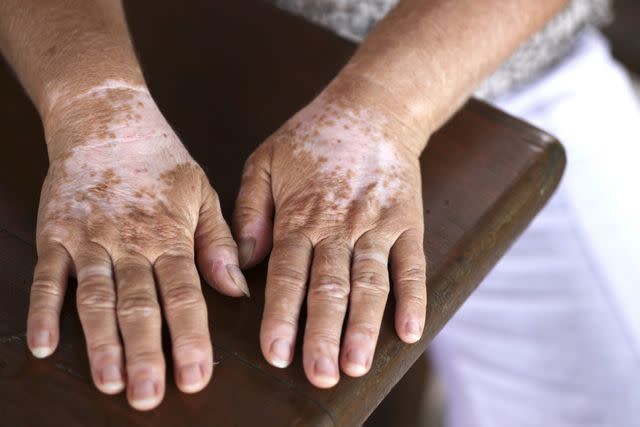What Causes Vitiligo?
Medically reviewed by William Truswell, MD
Vitiligo is a skin condition that causes loss of pigmentation in areas around the body. Researchers do not know the exact cause of vitiligo, but stress and exposure to chemicals might make it worse.
Vitiligo can affect any external part of the body, including the genitals, eyes, and inside of the mouth. Loss of pigmentation generally starts on the hands, feet, forearms, and face.

BSIP / Getty Images
Related: What Causes an Itchy Scalp—And How Do You Treat It?
Theories
People with vitiligo have areas of depigmented skin in various shapes and sizes. The exact cause of vitiligo is unknown, but researchers have proposed different theories.
Autoimmune Disorder
Vitiligo is an autoimmune disorder, which happens when the body recognizes healthy cells as harmful and attacks itself. The body attacks melanocytes, or the cells that produce melanin, in vitiligo.
Vitiligo is associated with other autoimmune disorders, including:
Addison's disease (adrenal insufficiency): This is when the adrenal glands, which sit above the kidneys, do not produce enough cortisol and aldosterone. Cortisol is a stress hormone that controls metabolism and helps respond to inflammation. Aldosterone regulates blood pressure and the levels of salt and water in your body.
Pernicious anemia: This is a condition that keeps your body from absorbing vitamin B12, which can negatively affect the nervous system. Symptoms include vomiting, diarrhea, and shortness of breath, especially during exercise.
Psoriasis: This skin condition accelerates the growth cycle of skin cells. It causes noticeable symptoms, such as pitted nails, redness, dryness, and cracked skin. The skin may also itch or burn, especially on the knees, scalp, and palms.
Thyroid disease: This is characterized by the thyroid (the butterfly-shaped gland in the neck) producing too many or too few hormones. Hyperthyroidism is too many hormones, while hypothyroidism is a lack of hormones.
Type 1 diabetes: The immune system attacks pancreas cells called islet cells, which produce insulin. Insulin is a hormone that controls your blood sugar.
Stress
Research has shown that people with vitiligo had high levels of perceived stress compared to those without. Stress may trigger the release of reactive oxygen species (ROS) by melanocytes. ROS is an unstable molecule that carries oxygen and can easily interact with others inside the cell. ROS build-up in the cell may damage the genetic material (DNA) and destroy the cell.
Chemical Exposure
Research has shown that chemical exposure may cause vitiligo or chemical-induced vitiligo. This occurs when you use products containing harmful chemicals, such as hair dyes or skin-lightening creams. These products may lead to pigment cell death when they come into contact with your skin.
These are some of the chemicals that may cause the skin to lose its color:
4-tert-butylcatechol (4-TBC), found in lubricating oils
Para-phenylenediamine (PPD), found in hair dyes
Phenol, found in detergents and cosmetic products
Rhododendrol, which was found in a skin-lightening cream
Is Vitiligo Hereditary?
Vitiligo can sometimes run in families. This can happen if you inherit the NLRP1 and PTPN22 genes and the genes experience variations. These genes normally help manage inflammation and the immune system's activity. The variations can inhibit them from doing so, leading to vitiligo.
A family history of vitiligo can increase your overall risk of developing it. About 20% of people with vitiligo have a first-degree relative with the same condition.
Who Gets Vitiligo?
Some people are more likely to develop vitiligo than others:
Age: Vitiligo can occur at any age, but white patches usually appear before age 20.
Genetics: You're more likely to develop non-segmental vitiligo if you have a close relative who has it or another autoimmune disorder, such as rheumatoid arthritis.
Geographic area: Research has found a higher prevalence of vitiligo in people who live in Africa.
Related conditions: About 15% to 25% of people with vitiligo have an autoimmune disorder.
Sex: Vitiligo can develop in people of any sex, but it's more common in women.
Risk Factors
Some factors can worsen vitiligo or make you more prone to developing it. These factors are listed below, ranging from tattoos to physical trauma.
Tattoos
Tattoos can add color to the skin, which some people have used to try to add pigment to areas affected by vitiligo, but they are open wounds. A wound can cause something called the Koebner phenomenon, which triggers new spots of vitiligo to develop where the wound is. The new patches may appear about 10–14 days after the tattoo.
There are ways to cover up your patches if you have vitiligo. A safer option is to use skin dyes or makeup that matches your skin's color.
Cancer Treatment
Melanoma is a type of skin cancer that develops in the melanocytes. One treatment option for melanoma is called immunotherapy. Immunotherapy helps recognize cancer cells and destroy them. It also can attack healthy tissue, such as pigment cells, increasing your risk of vitiligo patches.
Physical Trauma
Sunburns can worsen vitiligo. This is because depigmented skin may be more sensitive to UV rays.
Protecting your skin from the sun is essential, even if you don't have vitiligo. Use sunscreen and reapply it every two hours when you're out. Choose broad-spectrum products with SPF 30 or higher, which offer protection against UVA and UVB rays.
Related: What Causes Dandruff?
A Quick Review
Vitiligo is a skin condition that causes the skin to lose its pigment in patches that vary in size and shape. Why people develop it remains unknown, but researchers consider it an autoimmune disorder. The immune system mistakenly kills pigment cells.
Vitiligo can affect anyone, but it's more likely to occur in those with thyroid disease, diabetes, or a family history of the condition. Using products that contain harsh chemicals or receiving cancer treatment may also trigger or worsen vitiligo.
For more Health.com news, make sure to sign up for our newsletter!
Read the original article on Health.com.

